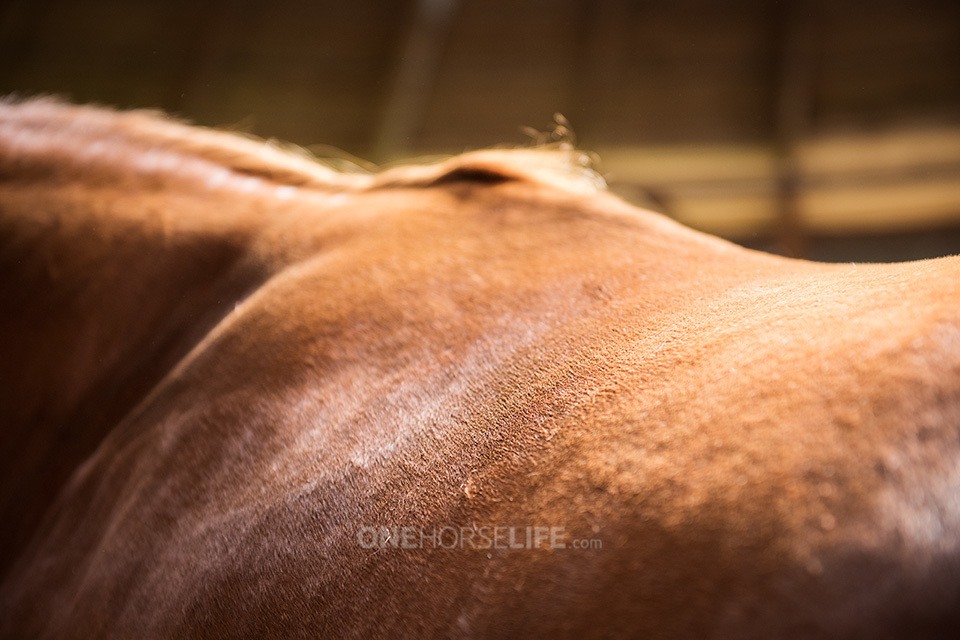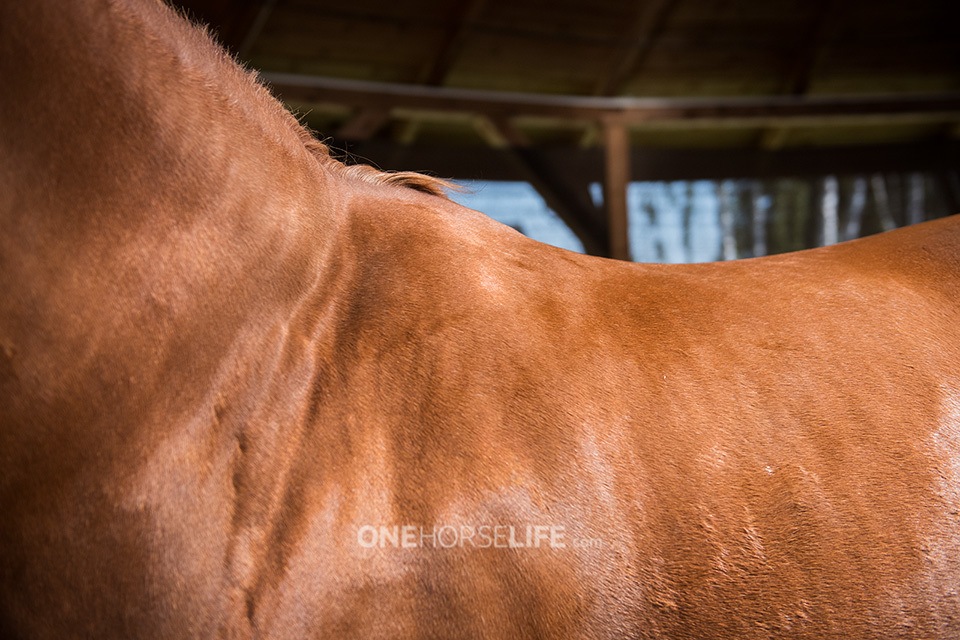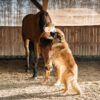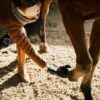I see many times how people seek ways to make their horses stronger and more balanced through endless repetitions of exercises and countless rounds of trot and canter, believing that only a strong horse can be a horse with a good balance. People look at the sports horses and they see most of all that they are strong, and have more muscles when compared to the pleasure horses. They also see that the sports horses have better balance than the pleasure horses, so they conclude that balance is the result of combination of strength and muscles. Nothing more wrong.
For a good balance is responsible not the amount of muscles or numbers of kilograms of the muscles, but accessibility of the muscles. Accessibility of the muscles is expressed by relaxation of the muscles. A tensed muscle is already a muscle at work, you have no access to this muscle. If accessibility of the muscles is good, the muscles grow naturally because they are well nurtured with blood (which tension makes impossible, this is why you can also see many sports horses that are very thin and have problems with gaining weight; stress and tensions in the muscles can be responsible for that very much). But then the number and quality of the muscles are the effect of their accessibility.


You can experience it yourself: clench your fist really hard, and keep it clenched like that for some time without loosening the grip. And now, try to clench it even more! Easy? Not so easy, simply because your fits and the muscles responsible for clenching it are already at work.
This applies not only to being in movement. Even when your horse is standing still, but is tensed, he cannot access the muscles needed for accelerating into a transition. He has a very little access to this action, simply because muscles that he needs to use, are already tensed. What happens next? If you ask a tensed horse for more movement or for a transition, or more energy, your horse has to use other muscles that were not meant by design to take part in realization of this movement. This, in time, creates wrong movement patterns and is responsible for injuries. On the every day basis it also is responsible for the unnecessary effort that your horse has to put into the tasks he is asked to perform. This makes most of the exercises look heavy, disengaged, and when the effort is really big, simply ugly. But it also tires your horse, his muscles and is responsible for that in many cases a 16yo horse is sent on the fields for an early retirement. He needs this early retirement simply because all his life he has worked very hard. Too hard. Not because he was asked for much, but because he was doing it with so much unnecessary effort!!!
 – relaxed muscles should look and feel like water in plastic bags.
– relaxed muscles should look and feel like water in plastic bags.
When you look later at different horses and their movements that start without Body Awareness: through speeding up, tensing and hastiness, you can almost feel how these movements are empty and are lacking the Body Awareness and balance. Many times with the lack of Body Awareness, follows lack of beauty, and when the movement and the horse lack beauty we no longer can talk about art, we can only talk about training and riding from E to B.
Being with horses was always meant to be an art.
As an Art we call only something that changes, inspires and touches the soul of the observer. If the painting, movement (a dance or a horse moving) lacks these qualities we can no longer talk about an art, it’s just a painting and a movement. And this is how true art, which was expression of one’s connection to his True Self and that was aimed to awaken the very same connection and states of awareness in the observer, disappeared and was replaced by something else: the techniques, the correctness and accuracy. This is how dressage riding was downgraded to riding straight lines and traveling from E to B on 20m circle. When we do not see Art, we can no longer speak about Art, we can only talk about techniques, because the technique is what is left.
To see art, we first need it to be an art. Without existence of an art, we won’t experience it. Many people lost their lives on seeking artistic experiences and spirituality where they do not and cannot simply exist. You cannot see art in mare training, but a mare training can become an art if it’s done by the artist and in artistic way. And then it can become an Art.
The piece of Art exists on its own, but it’s brought to live through an Artist, so we can all witness it with our senses. So to witness art, we need to have an artist. Who is an artist? An artist is a person who is connected to the core of his existence and expresses it on the outside of him and through what he does. The horse trainer has to become an artist in the process of training, and this – the existence of artists being able to create art – should be the main goal of dressage training if we want it to be an art.
Only an artist can create an art. An artist naturally will take only such actions and will fulfill these actions in such a way that they are strengthening his connection to his Self and are expressing it on the outside of him with greater and greater power. When the expression is pure and unpolluted with tensions, it can touch, inspire and change observers who look at it. And when it happens the essence of the existence of art is fulfilled. The cycle is closed. And this should be another goal of being with a horse, and of dressage if we want to see it as art.
In my eyes, teaching students with their horses should be always based on supporting them in becoming artists, so on deepening their connection with themselves and stripping them away from tensions so this connection can be freely and without any pollution from the limiting mind expressed through their actions.
It is always my great pleasure to see more and more artists emerging among OneHorseLife Students:
https://www.facebook.com/maria.blumenthal/videos/10155178543472790/
– Maria Blumenthal creating art and expressing art with her mare Thia.
Today I also want to show you you can see Cour d’Alaine who will turn 6yo in June this year, and you can see how his balanced is greater and increased if compared with that of Cadeau de Dieu’s {that I showed earlier today in our JoinAnna program}, and how his body is even more relaxed, all muscles looking and feeling like water in plastic bags, no matter what he does, and how beautiful the whole process is. There is no effort, only lightness. And this lightness opens the gate to a greater Balance and Body Awareness.
The whole process is effortless. As should be everything that you do with your horse:
In this beautiful video you can also see how I introduce the middle-high working frame to my horses before I ask for it from the saddle. Only when the horse is comfortable, relaxed and shows a great Balance and great Body Awareness in such a frame in all three gaits from the ground without showing any tensions– I ask for it slowly from the saddle. Usually I can ask for it at the end of the 6th year of the horse, and then the true riding begins, but the Art of our being together began long before :-)



wonderful to witness. following you and very grateful for your videos and explanations.